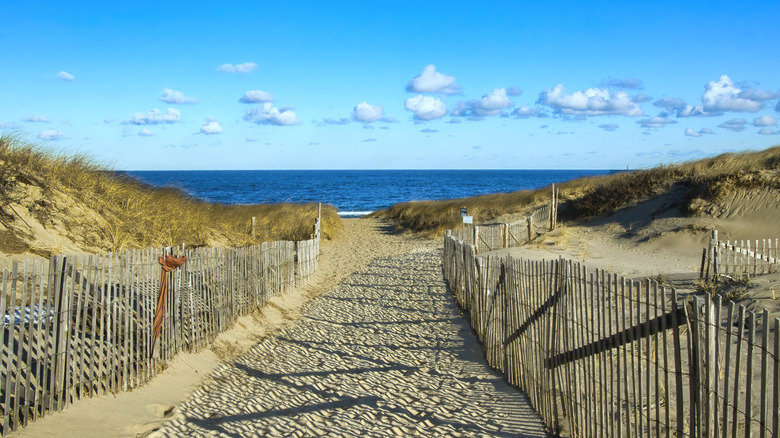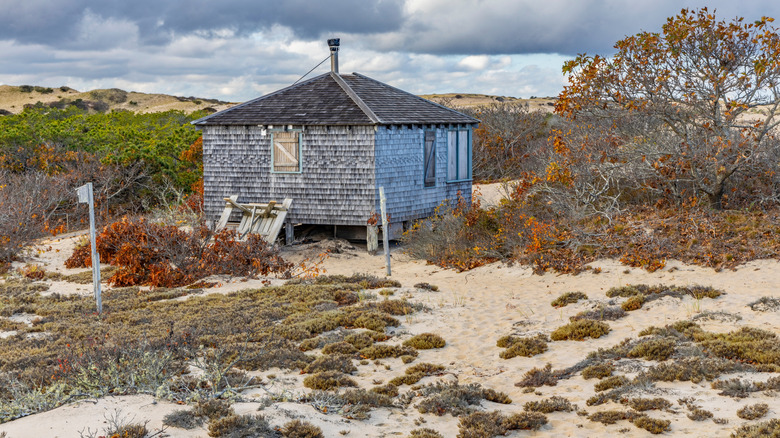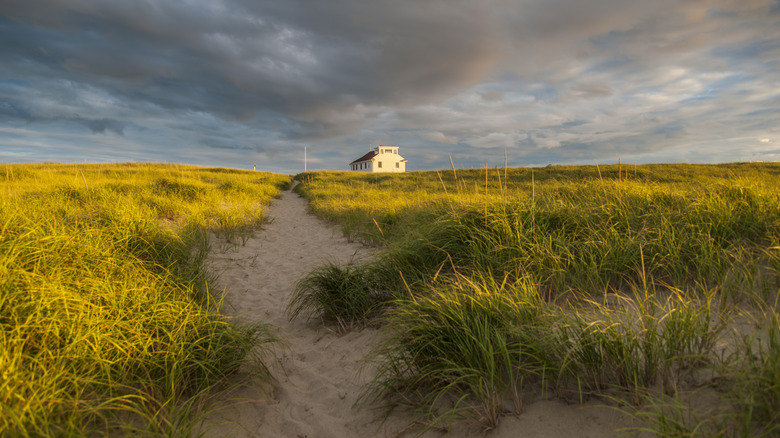Cape Cod's Serene Dunes That Span Miles Of Massachusetts' Coastline Are A Beautiful Beach Paradise
Clamshacks, shingled cottages, and rolling sand dunes border the Atlantic Ocean in Cape Cod, Massachusetts' arm-shaped peninsula. Often referred to simply as "the Cape" by locals, it's been one of New England's most popular summer destinations since the late 19th century, when trains transported Boston day trippers to the beaches. The construction of U.S. Route 6 and Route 6A, a breathtaking road that passes through quirky oceanside towns, led to even more growth throughout the 1950s. Photographs from the early 1960s even show John F. Kennedy and his family vacationing by dunes in Hyannis Port.
The region still gets most of its traffic between Memorial Day and Labor Day, when populations in some towns at the tip of the peninsula can grow by almost 1,000%. The Cape Cod National Seashore and its famous sand dunes span about 40 miles along the Massachusetts coastline between Chatham, named the world's great white shark capital, and Provincetown, known for its LGBTQ+ friendly events and art scene. Wind and waves have changed the hills' topography over the years, and they're certainly not the same dunes the Kennedys would have photographed beside in the '60s. Still, they've continued to attract vacationers looking for a beautiful beach paradise to escape their busy lives.
Dunes along the Cape Cod National Seashore are frequented by artists
Provincetown, America's oldest continuous art community, is located on the tip of the Cape Cod peninsula. Some creatives come for long-term stays in Provincetown's rustic "dune shacks" to work on their latest projects, per The Provincetown Community Compact. You won't find electricity or plumbing inside these 19th-century seaside homes — the dunes and ocean views are enough to keep artists inspired.
Those who prefer 21st-century amenities (like running water, TV, and parking) can book stays in bed and breakfasts closer to downtown Provincetown, where they'll still be close to the dunes and the sea. The Harbor Hotel has retro and pet-friendly rooms, and top-rated restaurants like the Lobster Pot and Sal's Place are a short trip away down Commercial Street. Vacationers can also schedule sunset cruises from Flyer's Boat Rental.
Chatham, another eclectic Cape Cod destination known for its dunes, is a 36-mile drive from Provincetown via Route 6. At Chatham Bars Inn, one of the town's best-known luxury hotels, front-facing rooms look out onto the Atlantic Ocean, sand bars, and distant cargo ships. Nearby, dunes at Monomoy National Wildlife Refuge serve as a habitat for piping plovers and some species of owls as well as coastal heath, grass, and lichens. Visitors to Chatham's Lighthouse Beach keep an eye out for dorsal fins in the water.
Explore Cape Cod's dunes in off-roading vehicles
Although exploring Cape Cod's beaches and dunes on foot can be a peaceful way to enjoy the landscape, it can also mean lots of walking, which, especially on an uneven surface like sand, requires a considerable amount of effort and electrolytes. Alternatively, those with off-roading permits and four-wheel drive can tour the Cape Cod National Seashore in their own vehicles. Restrictions might apply depending on seabird nesting or erosion — on some beaches, signs ask visitors to "Keep Off the Dunes," and some hills are sealed off with fencing. That being said, Sandy Neck Beach in West Barnstable and Nauset Beach in Orleans are typically open to the public, as long as you have a permit.
You might have better luck paying a guide. Private vehicles aren't allowed in Provincetown's Peaked Hill Bars Historic District, but visitors can pay for daily tours with Art's Dune Tours. The hourlong excursions take you across the dunes and past the seashore's famous dune shacks in an SUV for over $40 per person at the time of writing.
Although wind and water have changed the Cape's landscape over the years, it's still a prestigious beach paradise. The peninsula has attracted — and continues to attract — presidential families like the Kennedys, Clintons, and Obamas; musicians like Patti Page, who famously paid homage to the "sand dunes and salty air"; and impressionists like Edward Hopper, who preserved the dunes' beauty in paint.


